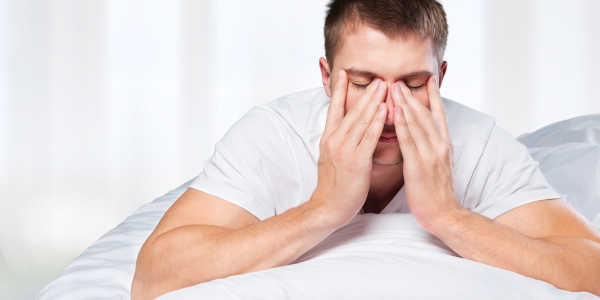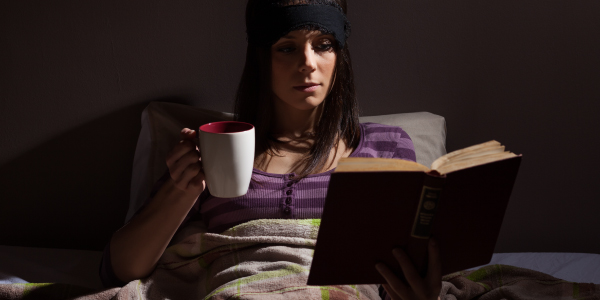
Do you have difficulty falling asleep? Problems breathing during sleep? Or general issues disrupting your sleep and wake cycle? Are you concerned these occurrences could be the sign of short-term insomnia, or perhaps something more serious? No matter the symptoms, it’s important to discover the underlying cause of your sleep problems. Especially if you’ve found yourself counting sheep night after night wondering, What is wrong with me? Do I have a sleep disorder?

What are the 5 Types of Sleep Disorders?
1. Insomnia
Insomnia is a common sleep disorder characterized by the inability to sleep or maintain restful sleep through the night. Under this broader umbrella, there are two subtypes of insomnia that most diagnoses fall into:
- Sleep-onset insomnia refers to difficulty falling asleep and usually occurs in people who have difficulty relaxing in bed or whose circadian rhythms are out of sync due to an environmental stressor, such as jet lag or excessive caffeine consumption.
- Sleep-maintenance insomnia refers to difficulty staying asleep and is most common in elderly sleepers and individuals who consume alcohol, caffeine, or tobacco before bed. This subtype can also be a sign of a different sleep disorder.
2. Sleep Apnea
Sleep apnea is marked by abnormal breathing during sleep, particularly multiple extended pauses between breaths. It is the most common sleep disorder in the US, affecting all demographic groups, though it’s most frequently observed in men. Sleep apnea falls into three subtypes:
- Obstructive sleep apnea (OSA) occurs when there is a physical blockage in the throat, causing a temporary lapse in breath.
- Central sleep apnea (CSA) involves the brain’s ability to control the muscles required in respiration, causing slowed or shallow breathing.
- Mixed sleep apnea, sometimes referred to as complex sleep apnea, is when a person has both OSA and CSA at the same time.
3. Narcolepsy
Narcolepsy is characterized by excessive daytime sleepiness, sleep paralysis, hallucinations, and in some instances, partial or total loss of muscle control (cataplexy). People experiencing narcolepsy feel exhausted throughout the day and may fall asleep involuntarily while doing normal activities. Narcolepsy blurs the boundaries between sleep and wakefulness, making its sufferers show characteristics of sleep while awake. Narcolepsy subtypes fall into two categories:
- Narcolepsy Type 1 involves the general symptoms of narcolepsy, but people diagnosed with this subtype will experience sudden muscle weakness and loss of facial control for the duration of the episode.
- Narcolepsy Type 2 is the less severe of the two subtypes, holding only the common symptoms without the added muscle weakness associated with cataplexy.
4. Restless Legs Syndrome (RLS)
Restless leg syndrome, or Willis Ekbom disease, is characterized by an uncomfortable itching, prickling, pulling, or crawling sensation that creates an overwhelming urge for the person to move their legs. Though RLS doesn’t exclusively affect sleep, its symptoms often worsened during periods of inactivity, causing a disruption in sleep. RLS is more common in individuals who also have periodic limb movement disorder, another condition affecting lower-limb movement.
5. REM Sleep Behavior Disorder
REM sleep behavior disorder is a type of parasomnia (abnormal sleep behavior) associated with various neurological disorders in which a person’s body doesn’t experience temporary paralysis during REM, or rapid eye movement, sleep. This allows them to move and vocalize fully and freely while asleep. During these episodes, the person can be observed as acting out their dreams, which tend to be intense and frightening.

How Can You Tell if You Have a Sleeping Disorder?
Although there are more than one-hundred types of sleep disorders recognized by the medical community, their general effects on the body remain relatively standardized across the spectrum. Common symptoms include:
- Excessive daytime sleepiness
- Difficulty falling asleep or staying asleep
- Falling asleep at inappropriate times, such as while driving
- Unusual breathing patterns around bedtime
- Uncomfortable urge to move while trying to fall asleep
- Unusual or bothersome movements or experiences during sleep
- Irregular sleep/wake cycles

Treatment Options for Problem Sleepers
Determining how to treat sleep problems depends on the symptoms a person is experiencing. For some sleep disorders, such as sleep apnea and narcolepsy, medical attention is necessary to ensure your safety and wellbeing. And while the best option is always to get a valid diagnosis from a medical professional, we’ve compiled some at-home sleep tips for getting a better night’s sleep:
- Create a relaxing and comfortable sleep environment
- Avoid excessive light
- Drop the ambient temperature
- Set and adhere to a fixed wake-up time
- Adjust your sleep schedule gradually
- Be mindful of naps
- Create a pre-bed wind-down routine
- Dim the lights
- Disconnect from electronics (TV, phone, email, etc.)
- Be proactive about sleep health during the day
- Limit alcohol and caffeine consumption
- Reserve your bed for sleep and sex only
- Keep a sleep diary to track symptoms and helpful sleep techniques
If none of these techniques are able to help you fall asleep or maintain restful sleep throughout the night and your lack of sleep is causing problems with your daytime functioning at school, work, or home, it’s time to talk to your doctor about a diagnosis and potential treatment options.
OakBend Medical Center
At OakBend Medical Center, we understand the frustration and disruption that disordered sleeping can cause in your daily routine. If you are experiencing any of the symptoms of common sleep disorders outlined above, our experts can help diagnose and treat the underlying issue.
Visit one of our locations in the Greater Houston area or contact us today if you’ve made it this far and still find yourself wondering, Do I have a sleep disorder?









Most Commented